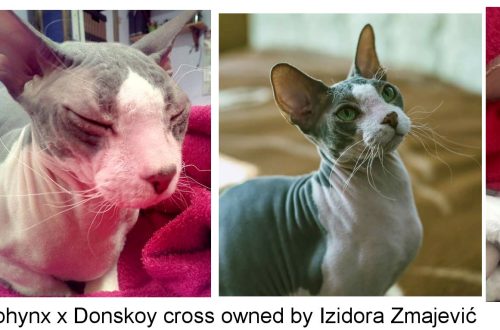
How cats and cats see our world
Contents
Features of vision of cats
The eyes of a cat are amazing in and of themselves. In relation to the size of the body of our mustachioed and purring pets, they are very large, and thanks to the convex shape, they provide a view of up to 270 degrees, which exceeds the human threshold. The eye color of different breeds is not the same, it varies from golden-light to dark green. There are cats with blue eyes, for example, Burmese.
In addition to the amazing ability of the pupils to expand and contract depending on the strength of the light flux, which simultaneously reflects the mood and feelings of our fluffy pet, the presence of a third eyelid in the cat’s eye is also impressive. It plays a protective role, protecting the organ of vision from drying out, foreign bodies and possible damage. This is especially important for predatory representatives of the cat family, in the process of hunting, making their way through various thickets. To see the third eyelid, it is not at all necessary to look into the eyes of a tiger or a lion – it is also perfectly visible in domestic cats. It is enough to catch a pet in a relaxed state with half-closed eyes.
And yet, how do cats see our world? It has been scientifically proven that the vision of domestic cats has a binocular type, which is characterized by the ability to simultaneously clearly see the image of an object with both eyes. This happens due to the overlapping of the surveyed areas in a certain way. This way of visual perception of the surrounding reality is important not only for orientation in the area, but also serves as an indispensable tool in hunting, allowing you to accurately determine where the prey is. Features of the structure of the eyes also help the cat to quickly respond to moving objects, and above all to those moving horizontally on the surface.
However, due to the location of the eyes deep in the skull, their movements are limited, and in order to view objects located on the sides, the animal must turn its neck. Playing with him, you can often notice how a cat shakes its head up and down before jumping. Such movements change the angle of her vision, which allows more accurate calculation of the distance to the prey. As for stationary objects, cats do not see them very well. It helps to track prey and the unusual structure of the pupil: it is vertical in cats (unlike a round human), which, depending on the amount of light, greatly expands or narrows.
Seeing cats in the dark
There is no doubt that cats can see well in the dark. But how good? And are their organs of vision capable of distinguishing anything in pitch darkness?
The ability of night vision is due to the peculiarities of the structure of the retina in muroks. It is equipped with rods and cones, that is, the same receptors as the retina of the human eye. However, there are also differences. For example, cats have fewer cones, which are responsible for color vision, than rods. And significantly: 20-25 times. At the same time, the eyes of mustachioed domestic predators are equipped with light-sensitive receptors. There are a lot of them, which allows cats to navigate in low light conditions.
The back wall of the retina is lined with tapetum, a special substance with mirror properties. Thanks to him, the light falling on the sticks is reflected twice. As a result, our furry pets in low light conditions see much better than a person – about 7 times! Their vision at nightfall is very good in comparison with other animals. In the dark, the eyes of cats even glow, which evokes mystical associations. This feature determines just the same tapetum.
There is an opinion that cats see even in absolute darkness, but it has not been confirmed by scientific research. In the complete absence of light sources, cats, like people, are not able to distinguish between objects. Maybe that’s why cats feel comfortable in darkened rooms? Watch them in the dark, and you will see that they are perfectly oriented in space, do not stumble upon surrounding objects, and successfully hunt rodents.
What colors does a cat see?
It used to be believed that cats see the world in black and white, completely color-blind. Over time, this stereotype was refuted.
Of course, a cat’s vision is not fully colored, that is, they do not perceive the surrounding reality in such bright colors as people do. The perception of color by our home “sailors” is somewhat faded, they see the world as if in a haze. For example, colors such as red, orange and yellow are completely indistinguishable. But they see green, blue and gray colors perfectly. At the same time, the difference between blue and cyan, as well as white, purple and yellow, is not fixed by their organs of vision.
There was also an opinion that cats are able to distinguish many shades of gray, namely about 25. The basis for this version was that domestic cats most often prey on mice and rats, whose hair is colored in gray-brown tones. Since it has been proven that in conditions of poor lighting, the eyes of cats retain the ability to distinguish gray, the version of the ability of these animals to distinguish many of its shades can be considered confirmed.
It may seem to many of our readers that nature, having “deprived” cats of full-fledged color vision in human understanding, significantly “deprived” their attitude, narrowed it down. In fact, these animals do not need their eyes to have such characteristics – if only because, unlike humans, they do not paint pictures and do not compose poetry. A cat is a predator, albeit a domestic one, and for a full-fledged hunt and a comfortable life, there is no need to identify the surrounding objects by color. After all, in order to realize the hunting instinct, it is important for the Murka not to miss the movement of potential prey around the area. And such a “trifle” as the color of the coat, for the implementation of this task does not matter.
If you want to learn more about the color component of cat vision, check out the work of American artist and researcher Nicolai Lamm. With the help of photographic illustrations, he tried to reflect in what colors these gentle purring creatures perceive the surrounding reality. The master created his works with the involvement of ophthalmologists, felinologists and other specialists, that is, there is no near-scientific gag in them.
Seeing a cat from a distance
Our beloved cats, it turns out, “suffer” … farsightedness, that is, everything that is in front of them at a distance of closer than 50 cm, they do not distinguish. Therefore, when playing with a pet, there is no need to bring the toy too close to his muzzle. What is going on right in front of their nose, cats “see” with the help of smell and vibrissae. Vibrissae, specialized sense organs, are whiskers, hair near the eyes (“eyebrows”), on the upper and lower jaws, scanning the surrounding space. Small children, playing with kittens and adult cats, sometimes shear these important formations, thereby actually depriving their pets of near vision.
Meanwhile, at a distance of 1 to 20 meters (according to some sources, even up to 60 m), cats see clearly.
What does a cat see in the mirror and on TV?
Surely each of us at least once in his life watched how cats behave in front of a mirror. It is impossible to look at this without laughing: the animal, having pressed its ears, literally attacks it, arching its back and sticking out its mustache. Reacting so violently to their own reflection, the cats do not even realize that they are seeing themselves. In fact, they are not afraid of the reflection as such, but that they perceive it as the presence of another animal, information about which is not transmitted by auditory and tactile receptors. They simply cannot understand how it happens that they see their relative in front of them, but at the same time they cannot even feel his smell.
As for the TV, most researchers claim that our four-legged friends only see flicker, but objects moving on the screen still interest them to some extent. For example, cats like to watch programs about animals. They, without taking their eyes off, as if spellbound, follow the flight of birds, the hunting of tigers, lions and other felines. If you turn off the sound, it will not affect the cat in any way, it will continue to watch. But as soon as you change the channel, your cat will lose interest in what is happening on the screen and even leave the room. How cats selectively see or understand that “their own” or the same birds (object of hunting) are shown on TV, scientists cannot yet understand.
How do cats see people?
Cats see their owner, and all people, as they really are – by height, physique, body weight, and so on. Unless mustachioed pets visually perceive us in a slightly different color. If a person is close, cats distinguish the features of his face poorly, being guided only by smell. If the owner is at a distance, then the animal sees only the outlines of the figure without detailed details. Some zoologists put forward a version that cats perceive people as their larger relatives who feed them, care for them and take care of them.
Be that as it may, the vision of domestic cats is unique. It is a complex mechanism that has evolved over a long evolutionary path. Due to the special structure of the eyes, their location on the face of the animal and the ability to see potential prey even in low light conditions, cats not only managed to survive in the course of natural selection, but also became, perhaps, the most successful hunters in comparison with other animals. Knowledge by us, people, of the features of visual perception of these amazing animals of the surrounding world helps us to better understand them and become even closer to them.





